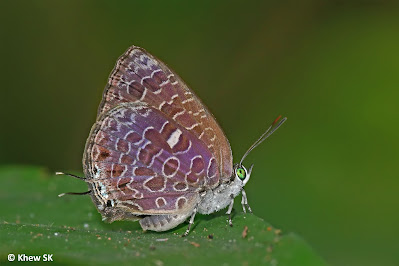The Lesser Malayan Oakblue (Arhopala ammon ammon)
The first half of 2025 is almost over, and the world has become even more unstable with at least several wars ongoing that leaves us wondering if emotions will boil over and these hostilities will tear the world apart. With ordinance raining between countries like Russia-Ukraine, Israel-Palestine and Israel-Iran, and the US joining in, pounding Iran's nuclear sites, it is a wonder when other superpowers will join in the skirmishes. Is diplomacy no longer working, that makes these offensive attacks that kill people the only way forward? When will our world enjoy peace again?
All it takes is one of the nuclear powers to lose control that we will experience Armageddon. There will be no winners in any war in today's context. It's not about counting who has the most nuclear warheads or bombs. Once one is launched, there will be no looking back, or hitting a reset button. We can only hope that common sense and restraint by the political powers is exercised if we want to continue living safely on this earth.
Over in Southeast Asia, governments are voicing concern over the hostilities but are also taking steps to ensure closer collaboration amongst the ASEAN countries in terms of trade and economic partnerships. With the US distracted with tariffs and self-interest, there seems to be no longer a "guardian" of the world anymore. It's every country for itself and for the smaller and weaker countries to form alliances to protect themselves.
A Lesser Malayan Oakblue perched in the forest understorey. Note the purple wash on the hindwing and forewing apical area.
Our Butterfly of the Month for June 2025 is the rare Lesser Malayan Oakblue (Arhopala ammon ammon). This species is one of the smaller Arhopala species, with a wingspan of about 30mm. A species that prefers the heavily shaded forested areas within the Central Catchment Nature Reserve, it can sometimes be mistaken for the similar sized Aberrant Oakblue (Arhopala abseus abseus) particularly in weathered individuals. Some references incorrectly refer to A. ammon as the Malayan Oakblue, which is actually the common name reserved for another species - Arhopala myrzala lammas. Yet other literature refers to it by another common name - Malayan Bushblue.
The Lesser Malayan Oakblue belongs to the ganesa group of the genus Arhopala and all the species are rare, with this species "seen with some regularity in Singapore" (ref pg 251 C&P5). From our records, it was regularly seen in the forests around Upper Seletar Reservoir Park in very localised patches between 2006 and 2016. There was an outing when 3 individuals were spotted in the same location! During that period, most of active photographers in ButterflyCircle managed to encounter and get shots of the Lesser Malayan Oakblue.
However, in recent years, it seems to have become very rare, with the last sighting of a pristine individual recorded in Aug 2019. Due to its rarity, it has been classified as "Endangered" in the Singapore Red Data Book 3rd Edition. It has been almost 6 years since the last individual was observed, and a mystery as to why the species has been absent from the locations where it used to frequent. The vegetation at its preferred habitats has not changed much, so there could be other reasons for its disappearance.
The Lesser Malayan Oakblue prefers to lurk in the shaded understorey of forested areas and is usually perched on the uppersides of foliage with its wings folded upright. At times, it will stay quite still on the same perch unless disturbed. It can be quite skittish and takes off to the treetops very quickly.
The male Lesser Malayan Oakblue is dark purple blue above with narrow black borders on both wings. Females are a lighter purple blue with broad black borders. Most of the dark brown spots on the underside of the hindwing are edged in white, giving it a very different appearance than most of the other species in the genus. There is a purple wash on the hindwing underside and the apical area of the forewing in pristine individuals, especially when viewed in a sidelight.
The species is characterised by a large solid white spot in space 7 of the underside of the hindwing. There is a short filamentous white-tipped tail at vein 2 of the hindwing. There are greenish scales crowning the black tornal spots on the hindwing. The eyes are typical Arhopala iridescent green.
Text by Khew SK : Photos by KhewSK, Loh MY, Horace Tan, Anthony Wong and Mark Wong











No comments:
Post a Comment